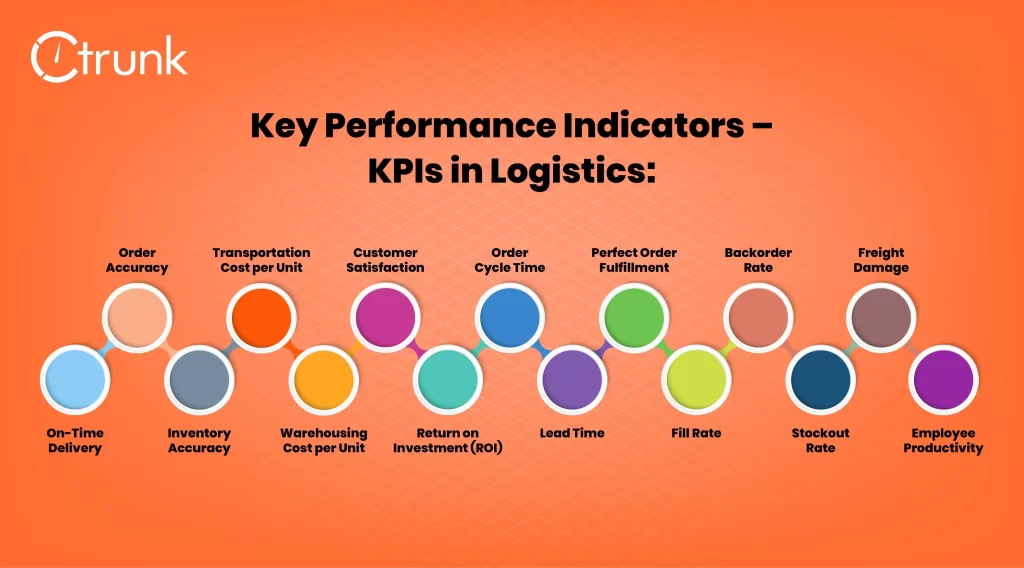Top 7 Strategies for Courier Services Advertising!


Logistics plays a critical role in the success of any business that deals with the movement of goods. In order to assess and improve the efficiency of logistics operations, it is important to monitor and measure Key Performance Indicators (KPIs). These KPIs in logistics provide valuable insights into various aspects of the logistics process, helping businesses identify areas for improvement and make informed decisions.
In the fast-paced world of logistics, businesses need to have a comprehensive understanding of their performance metrics to stay competitive. Key Performance Indicators (KPIs) serve as benchmarks that enable companies to evaluate their logistics operations and measure success. By tracking and analyzing these KPIs, businesses can identify bottlenecks, optimize processes, and enhance overall efficiency.

On-time delivery is a crucial logistics KPI that measures the ability to deliver products or goods within the specified timeframe. It reflects the reliability of logistics operations and directly impacts customer satisfaction. By closely monitoring on-time delivery rates, businesses can identify areas of improvement and take corrective actions to ensure timely deliveries.
Order accuracy is another important KPI in logistics. It measures the percentage of orders that are fulfilled accurately and without errors. A high order accuracy rate indicates efficient inventory management, reducing the need for costly returns or replacements. By focusing on order accuracy, businesses can improve customer satisfaction and minimize order-related issues.
Inventory accuracy is also a crucial KPI that measures the reliability of inventory records. It reflects the ability to maintain accurate stock levels and avoid stockouts or overstock situations. By regularly monitoring and reconciling inventory records, businesses can minimize carrying costs, streamline order fulfilment, and enhance overall supply chain efficiency.
Transportation cost per unit is a financial KPI that assesses the cost-effectiveness of transportation operations. It calculates the average cost incurred to transport each unit of goods. By optimizing transportation routes, consolidating shipments, or negotiating better freight rates, businesses can reduce transportation costs and increase profitability.
Warehousing cost per unit is also a financial KPI that evaluates the efficiency of warehousing operations. It measures the average cost incurred to store each unit of inventory. By implementing effective warehouse management strategies, businesses can reduce warehousing costs, improve inventory turnover, and maximize warehouse space utilization.
Customer satisfaction is a vital KPI in logistics that directly impacts the reputation and success of a business. It measures the level of satisfaction customers experience with the overall logistics services provided. By collecting feedback, addressing customer concerns, and continuously improving service quality, businesses can enhance customer loyalty and gain a competitive edge.
Return on Investment (ROI) is a financial KPI that assesses the profitability of logistics operations. It calculates the return generated from the investment made in logistics activities. By analyzing ROI, businesses can identify cost-saving opportunities, allocate resources effectively, and optimize logistics processes to maximize profitability.
Order cycle time is a time-based KPI that measures the duration from order placement to order fulfilment. It reflects the speed and efficiency of order processing and delivery. By reducing order cycle time, businesses can improve customer satisfaction, increase order frequency, and gain a competitive advantage in the market.
Lead time is another time-based KPI that measures the duration from order placement to order delivery. It includes order processing, manufacturing, transportation, and any other activities involved in fulfilling the order. By minimizing lead time, businesses can enhance customer satisfaction, reduce inventory holding costs, and improve overall operational efficiency.
Perfect order fulfilment is a comprehensive KPI in logistics that measures the percentage of orders delivered without any errors or issues. It considers various factors such as on-time delivery, order accuracy, and complete documentation. By striving for perfect order fulfilment, businesses can minimize returns, improve customer satisfaction, and build a reputation for reliable logistics services.
Fill rate is a crucial KPI that measures the percentage of customer demand fulfilled from available inventory. It reflects the ability to meet customer requirements promptly. By maintaining a high fill rate, businesses can avoid stockouts, reduce lost sales opportunities, and improve customer loyalty.
The backorder rate is a KPI that measures the percentage of orders that cannot be fulfilled immediately due to stock unavailability. It reflects the efficiency of inventory management and supply chain coordination. By reducing backorder rates, businesses can improve order fulfilment, enhance customer satisfaction, and minimize revenue loss.
Stockout rate is a KPI that measures the frequency and duration of stock unavailability. It reflects the adequacy of inventory levels to meet customer demand. By closely monitoring and reducing stockout rates, businesses can avoid lost sales, improve customer satisfaction, and optimize inventory management processes.
Freight damage is a KPI that measures the percentage of goods damaged during transportation. It reflects the effectiveness of packaging, handling, and transportation methods. By implementing proper packaging practices, ensuring safe handling, and selecting reliable carriers, businesses can minimize freight damage and reduce associated costs.
Employee productivity is a KPI that assesses the efficiency and effectiveness of the workforce involved in logistics operations. It measures factors such as order picking speed, order accuracy, and overall output. By providing training, implementing performance metrics, and fostering a positive work environment, businesses can enhance employee productivity and optimize logistics processes.
In the world of logistics, monitoring and measuring Key Performance Indicators (KPIs) is essential for maintaining operational excellence. The KPIs discussed in this article provide valuable insights into various aspects of logistics operations, ranging from on-time delivery and order accuracy to inventory management and customer satisfaction.
By focusing on these important KPIs, businesses can identify areas for improvement, optimize processes, and achieve higher levels of efficiency and customer satisfaction.